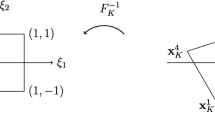Abstract
In this paper we generate optimized Runge-Kutta stability polynomials for multidimensional discontinuous Galerkin methods recovered using the flux reconstruction approach. Results from linear stability analysis demonstrate that these stability polynomials can yield significantly larger time-step sizes for triangular, quadrilateral, hexahedral, prismatic, and tetrahedral elements with speedup factors of up to 1.97 relative to classical Runge-Kutta methods. Furthermore, performing optimization for multidimensional elements yields modest performance benefits for the triangular, prismatic, and tetrahedral elements. Results from linear advection demonstrate these schemes obtain their designed order of accuracy. Results from Direct Numerical Simulation (DNS) of a Taylor-Green vortex demonstrate the performance benefit of these schemes for unsteady turbulent flows, with negligible impact on accuracy.










Similar content being viewed by others
Data Statement
Data relating to the results in this manuscript can be downloaded from the publication’s website under a CC BY-NC-ND 4.0 license.
Change history
02 October 2021
The first and last name order of the author Siavash Hedayati Nasab was corrected.
References
Huynh, H.T.: A flux reconstruction approach to high-order schemes including discontinuous Galerkin methods. 18th AIAA Computational Fluid Dynamics Conference (2007)
Butcher, J.C.: Numerical methods for ordinary differential equations. Willy, Hoboken (2002)
Hairer, E., Nørsett, S.P., Wanner, G.: Solving ordinary differential equations I: nonstiff problems. Springer, NewYork (1993)
Wanner, G., Hairer, E.: Solving ordinary differential equations I: stiff and differential-algebraic problems. Springer, NewYork (1996)
Ketcheson, D.I., Ahmadia, A.J.: Optimal stability polynomials for numerical intergration of initial value problems. Commun. Appl. Math. Comput. Sci. 7(2), 247–271 (2012)
Kubatko, E.J., Yeager, B.A., Ketcheson, D.I.: Optimal Strong Stability Preserving Runge-Kutta time discretizations for discontinuous Galerkin methods. J. Sci. Comput. 60(2), 313–344 (2014)
van Der Houwen, P.J., Sommeijer, B.P.: On the internal stability of explicit, m-stage Runge-Kutta methods for large m-values. ZAMM-J. Appl. Math. Mech. 60(10), 479–485 (1980)
Ruuth, S.J.: Global optimization of explicit Strong stability preserving runge-kutta methods. Math. Comput. 75(253), 183–207 (2006)
Ruuth, S.J., Spiteri, R.J.: High-order strong stability preserving Runge-kutta methods with downwind-biased spatial discretizations. SIAM J. Numer. Anal. 42(3), 974–996 (2004)
Parsani, M., Ketcheson, D.I., Deconinck, W.: Optimized explicit Runge-Kutta schemes for the spectral difference method applied to wave propagation problems. SIAM J. Scientific Comput. 35(2), A957–A986 (2013)
Vermeire, B.C., Loppi, N.A., Vincent, P.E.: Optimal Runge-Kutta schemes for pseudo time-stepping with high-order unstructured methods. J. Comput. Phys. 383, 55–71 (2019)
Vermeire, B.C.: Paired explicit Runge-Kutta schemes for stiff systems of equations. J. Comput. Phys. 393, 465–483 (2019)
Vermeire, B.C., Hedayati Nasab, S.: Accelerated implicit-explicit Runge-Kutta schemes for locally stiff systems. J. Comput. Phys. 429, 110022 (2020)
Ascher, U.M., Ruuth, S.J., Spiteri, R.J.: Implicit-explicit Runge-Kutta methods for time-dependent partial differential equations. Appl. Numer. Math. 25(2–3), 151–167 (1997)
Shoeybi, M., Svärd, M., Ham, F.E., Moin, P.: An adaptive implicit-explicit scheme for the DNS and LES of compressible flows on unstructured grids. J. Comput. Phys. 229(17), 5944–5965 (2010)
Hundsdorfer, W., Jaffré, J.: Implicit-explicit time stepping with spatial discontinuous finite elements. Appl. Numer. Math. 45(2–3), 231–254 (2003)
Kanevsky, A., Carpenter, M.H., Gottlieb, D., Hesthaven, J.S.: Application of implicit-explicit high-order Runge-Kutta methods to discontinuous Galerkin schemes. J. Comput. Phys. 225(2), 1753–1751 (2007)
Vermeire, B.C., Nadarajah, S.: Adaptive IMEX schemes for high-order unstructured methods. J. Comput. Phys. 280, 261–286 (2015)
Matlab 2016a. Mathworks, 2016
Grant, M., Boyd, S.: CVX: Matlab software for disciplined convex programming. (2013)
Haga, T., Sawada, K., Wang, Z.J.: An implicit LU-SGS scheme for the spectral volume method on unstructured tetrahedral grids. Comun. Comput. Phys. 6(5), 978 (2009)
Haga, T., Gao, H., Wang, Z.J.: A high-order unifying discontinuous formulation for the Navier-Stokes equations on 3D mixed grids. Math. Model. Nat. Phenom. 6(3), 28–59 (2011)
Moura, R.C., Sherwin, S.J., Peiro, J.: Linear dispersion-diffusion analysis and its application to under-resolved turbulence simulations using discontinuous galerkin spectral/hp methods. J. Comput. Phys. 298, 695–710 (2015)
Vincent, P.E., Castonguay, P., Jameson, A.: Insights from Von Neumann Analysis of High-Order flux reconstruction Schemes. J. Comput. Phys. 230(22), 8134–8154 (2011)
Van den Abeele, K.: Development of High-Order Accurate Schemes for Unstructured Grids. Vrije Universiteit Brussel, Belgium (2009). (PhD Thesis at)
Yang, H., Li, F., Qiu, J.: Dispersion and dissipation errors of two fully discrete discontinuous galerkin methods. J. Scientific Comput. 55(3), 552–574 (2013)
Vermeire, B.C., Vincent, P.E.: On the behaviour of fully-discrete flux reconstruction schemes. Computer Methods Appl. Mech. Eng. 315, 1053–1079 (2017)
Vermeire, B.C., Vincent, P.E.: On the properties of energy stable flux reconstruction schemes for implicit large eddy simulation. J. Comput. Phys. 327, 368–388 (2016)
Pereira, C.A., Vermeire, B.C.: Fully-discrete analysis of high-order spatial discretizations with optimal explicit runge-kutta methods. J. Scientific Comput. 83(3), 1–35 (2020)
Castonguay, P.: High-order energy stable flux reconstruction schemes for fluid flow simulations on unstructured grids. Stanford University Press (2012)
Wang, Z.J., Fidkowski, K., Abgrall, R., Bassi, F., Caraeni, D., Cary, A., Deconinck, H., Hartmann, R., Hillewaert, K., Huynh, H.T., et al.: High-order CFD methods: current status and perspective. Int. J. Numer. Methods Fluids 72(8), 811–845 (2013)
Van Rees, W.M., Leonard, A., Pullin, D.I., Koumoutsakos, P.: A comparison of vortex and pseudo-spectral methods for the simulation of periodic vortical flows at high reynolds numbers. J. Comput. Phys. 230(8), 2794–2805 (2011)
Acknowledgements
We acknowledge the support of the Natural Sciences and Engineering Research Council of Canada (NSERC) [RGPAS- 2017-507988, RGPIN-2017-06773], and the Fonds de Recherche Nature et Technologies (FRQNT) via the New University Researchers Start Up Program. This research was enabled in part by support provided by Calcul Quebec (www.calculquebec.ca), WestGrid (www.westgrid.ca), SciNet (www.scinethpc.ca), and Compute Canada (www.computecanada.ca) via a Resources for Research Groups allocation.
Author information
Authors and Affiliations
Corresponding author
Additional information
Publisher's Note
Springer Nature remains neutral with regard to jurisdictional claims in published maps and institutional affiliations.
Supplementary Information
Below is the link to the electronic supplementary material.
Appendices
Appendices
Stability Plots
Rights and permissions
About this article
Cite this article
Hedayati Nasab, S., Pereira, C.A. & Vermeire, B.C. Optimal Runge-Kutta Stability Polynomials for Multidimensional High-Order Methods. J Sci Comput 89, 11 (2021). https://doi.org/10.1007/s10915-021-01620-x
Received:
Revised:
Accepted:
Published:
DOI: https://doi.org/10.1007/s10915-021-01620-x














